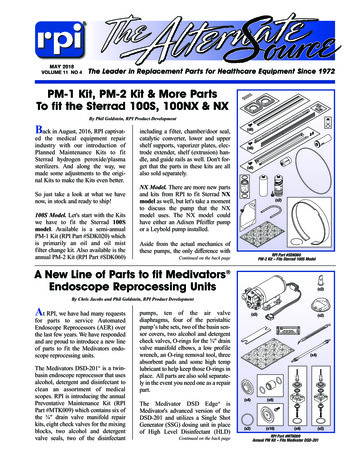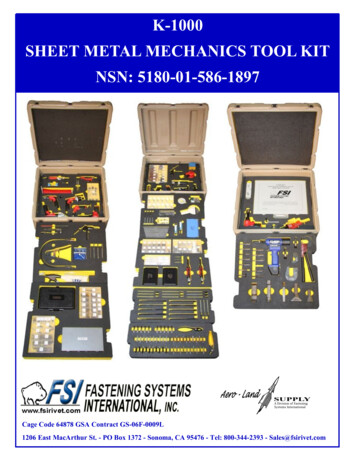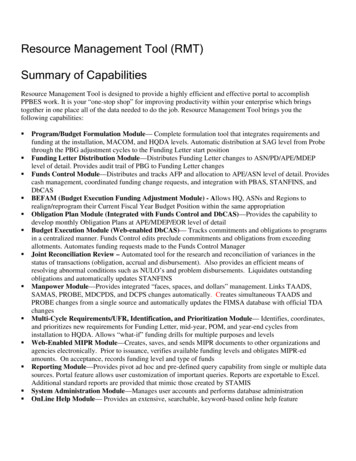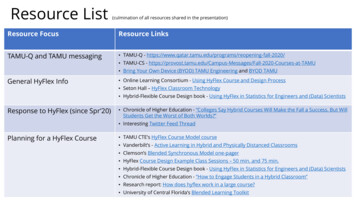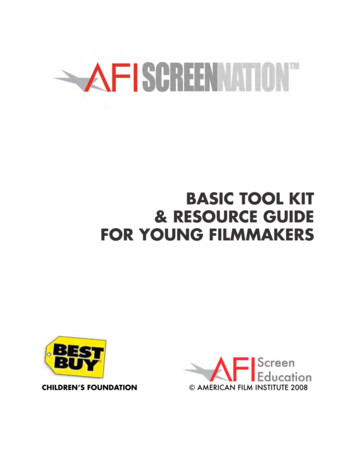
Transcription
BASIC TOOL KIT& RESOURCE GUIDEFOR YOUNG FILMMAKERSCHILDREN’S FOUNDATION AMERICAN FILM INSTITUTE 2008
FILMMAKER’S TOOL KIT GLOSSARY OF FILM TERMS STORYBOARD GLOSSARY OF COMMON FILM SHOTS GUIDE TO SCRIPT FORMATTING GUIDE TO 3-PONT LIGHTING BLANK STORYBOARDS PRODUCTION CALL SHEET PUBLISH AND CONNECTscreennation.afi.com2
GLOSSARY OF FILM TERMSGLOSSARY OF FILM TERMSIntroductionA consideration of the many disciplines involved in film production gives the motionpicture a much larger and more complex dimension. No longer can a film adaptation ofa novel or other literary work be considered a mere visual record when so much talent isinvolved in such a creative effort. Just as the various tasks in film production can bebroken down and analyzed individually, so can the individual elements of the film.Filmmaking, like any other art form, has its own language and vocabulary. Once thatlanguage is mastered, films can be understood at a new level.Camera angle: The position of the camera in relation to the subject it shows: above it,looking down (a high angle); on the same level (a straight-on angle); looking up (a lowangle).Close-up: A framing in which the scale of the object shown is relatively large. Mostcommonly, a personʼs head is seen from the neck up, or an object fills most of thescreen to emphasize its importance.Crane shot: A shot accomplished by having the camera above the ground and movingthrough the air in any direction.Crosscutting: Editing that alternates shots of two or more lines of action occurring indifferent places, usually simultaneously. Crosscutting is often used during a keydramatic sequence to increase tension.Deep Focus: A use of the camera lens and lighting so that both close and distantplanes are shown in sharp focus. This technique allows the filmmaker to emphasize acharacter or object that appears far away.Depth of Field: The area or field between the closest and farthest planes captured bythe camera, in which everything appears in sharp focus. A depth of field from five to 16feet, for example, would mean that everything closer than five feet and farther than 16feet would be out of focus.Dissolve: A transition between two shots during which the first image graduallydisappears while the second image gradually appears. For a moment, the two imagesblend in superimposition.screennation.afi.com
GLOSSARY OF FILM TERMSEstablishing shot: A shot that shows the relationship among important figures,objects, characters and setting at a distance. From the establishing shot, the film thencuts to more detailed shots (often called coverage) that bring the audience closer to thecharacters.Flashback: An alteration in the story order in which the plot moves back in time toshow events that have taken place earlier than those already shown.Focus: When light, people, places and objects are captured on film showing sharpoutlines and distinct textures through manipulation of the camera lens. There aredifferent types of focus, used to achieve specific effects.Frame: The rectangular box that contains the image projected on the screen. Thisperimeter is one of the filmmakerʼs most important tools. The frame is the window intothe world of a film. Within it, each shot is composed and the edges of the frame allowthe filmmaker to create a picture. Movies were first known as moving pictures, and thisdescription is still useful when considering the important role the frame plays as acompositional device. Through the cameraʼs eye, the viewer is presented with imagesthat convey the story. Within the frame, the filmmaker creates several different types ofshots, which are generally characterized by the relationship between the size of theelements in the frame to each other and to the frame itself.Long shot: A framing in which the scale of the object shown is not distant but relativelysmall. A standing human figure, for example, generally appears nearly the height of thescreen.Medium shot: A shot that shows human figures from the waist up.Pan (or panning shot): A camera movement with the camera body turning to theright or left. On the screen, it produces a mobile framing, which scans horizontally.Panning shots can also emphasize movement.Point of View (POV) shot: A shot taken with the camera placed where thecharacterʼs eyes would be to show what the character would actually see. This type ofshot is usually cut in before or after a shot of the character looking at whatever the POVshot contains.Wide angle: The use of a wide-angle lens to create a shot that captures a wide rangeof elements or objects on a single plane, while at the same time exaggerating thedistance between foreground and background planes.Zoom: A lens which allows the focal length—the distance between the camera and theobject being filmed—to change during a single shot. The camera can zoom in by goingcloser to an object, or it can zoom out by pulling back from an object.screennation.afi.com
GLOSSARY OF FILM TERMSBehind the CameraIn order to understand film as an art form, it is important to consider the jobs of thenumerous individuals who work together to make the film a reality.Producer: The person or group responsible for managing the production from start tofinish. The producer develops the project from the initial idea, makes sure the script isfinalized, arranges the financing, hires the personnel to make the film and oversees itsdistribution to theaters. The producer also coordinates the filmmaking process to ensurethat everyone involved in the project is working on schedule and on budget. Ironically,the producerʼs role is often invisible to the movie-going public, who tend to focus onactors and directors. Yet, without the producer at the helm, films do not get made.Director: The individual primarily responsible for overseeing the shooting andassembly of a film. He or she is most directly responsible for the pictureʼs finalappearance. The director is sometimes referred to as the author or auteur of a filmbecause of his or her essential involvement with its creation. While the director might becompared to a novelʼs author as a filmʼs primary visionary, he or she would not be ableto make the film without the help of numerous other artists and technicians. In fact, thenotion of the director as author is misleading because it assumes the director doeseverything—just like an author writes an entire book—which is not the case. A directorworks at the center of film production, but is inextricably linked with dozens of otherpeople to get the job done.Screenwriter: While the dialogue in a film may seem natural to the viewer, a writercarefully crafts it. The screenwriter does far more than provide dialogue for the actors.He or she also shapes the sequence of events in a film to ensure that one scene leadslogically to the next, with the story being told in a logical and interesting way. Whenusing a novel or play as a starting point, the screenwriter inevitably rearranges, adds oreliminates scenes to make sure the final order or sequence of scenes makes sensewhen presented on the screen. The screenwriter also includes descriptions of settingsand often suggests movements or gestures for the actors. Like the producer, thescreenwriterʼs role is generally overlooked by the movie-going public, yet is essential tothe completion of any film. If there is no script, there is no movie.screennation.afi.com
GLOSSARY OF FILM TERMSProduction Designer: Before one inch of film is shot, the production designer is thefirst artist to translate the script into visual form. He or she creates a series ofstoryboards that serve as the filmʼs first draft. A storyboard is a series of sketches,paintings or watercolors arranged on panels to show the visual progression of the storyfrom one scene to the next. The production designer determines the palette of colors tobe used and often provides important suggestions about the composition of individualshots. Creating this sketch of the film on storyboards also ensures the visual continuityof the film from start to finish. Storyboards serve as the directorʼs visual guidethroughout the production.Art Director: The art director is responsible for the filmʼs settings: the buildings,landscapes and interiors that provide the physical context for the characters. Artdirection and production design are often and easily confused. While the productiondesigner determines the big picture—the overall appearance, color palette and basicvisual composition of the film—the art director provides the individual pieces within thisframework, which includes everything but the actors themselves.Costume Designer: Costumes convey a great deal about the filmʼs time period andthe characters who wear them—their economic status, occupation and attitude towardthemselves.Cinematographer: After the production designer, art director and costume designerhave finished their work on the filmʼs physical elements, the director of photography, orDP, is responsible for capturing their handiwork on film or video. The DP is an expert inphotographic processes, lighting and the cameraʼs technical capabilities. When thedirector wants a shot to achieve certain visual or atmospheric qualities, the DP achievesit through his or her choice of lighting, film stock and careful manipulation of the camera.During shooting, the director and cinematographer work closely to shape each shot,using the storyboards created by the production designer as a guide. This craft isreferred to as cinematography.Editor: Shortly after shooting begins, the editor begins to organize the footage—knownas the daily rushes—and arranges individual shots into one continuous sequence. Evenin a single scene, dozens of different shots have to be chosen and assembled fromhundreds of feet of film. The editorʼs choices about which shots to use, and the order inwhich to place them, have a profound effect on the appearance of the final film.screennation.afi.com
GLOSSARY OF FILM TERMSActors: For the audience, actors are the most visible and tangible part of theproduction. While they are obviously essential to any film, they are pieces in a muchlarger puzzle. Behind every actor is a director guiding his or her performance, acinematographer creating the perfect light and film exposure, a screenwriter providingplot and dialogue, an art director designing the physical environment and a costumedesigner providing the proper attire. Considering an actorʼs role within this larger contextalso suggests that his or her job is much more difficult than just appearing on the setand reciting lines.Music: Music has been an integral part of movies since cinemaʼs earliest days in the1890s. A piano or organ player accompanied even the simplest silent films. The silentmovie palaces of the 1920s were equipped with elaborate organs and orchestra pits toaccommodate large groups of live musicians. When sound was integrated into thefilmmaking process, music, sound effects and dialogue became essential tools forenhancing a filmʼs visual qualities. Writing movie music has been a full-time professionsince the 1930s and is still a critical component in filmmaking.screennation.afi.com
GLOSSARY OF COMMON FILM SHOTSIntroductionStoryboards are illustrations displayed in sequence for the purpose ofcrafting an animated or live-action film.In preparing to shoot a motion picture, a storyboard provides a visual layoutof events as they are to be seen through the camera lens. Whenstoryboarding, most technical details involved in crafting a film can beefficiently described in pictures, or in corollary notation.A storyboard is essentially a large comic of the film or some section of thefilm, produced before filming to help directors and cinematographersvisualize scenes and identify potential problems before they occur. Somedirectors storyboard extensively before taking the pitch to their funders.Others only storyboard complex scenes, or not at all.In animation and special effects, the storyboarding stage is essential andmay be followed by simplified video mock-ups called “animatics” to give abetter idea of how the scene will look with motion.screennation.afi.com
SCRIPT FORMATTING GUIDESCRIPT FORMATTING GUIDECover / Title Page: Title & screenwriter(s) names in the middle. Contact information is located in the lower right corner.Page Margins: Top: 1.0" Bottom: 1.0" Left: 1.5" Right: 1.0"Font: Always use 12-point Courier; no bold face or italics. Use underlines instead.Page Numbering: Place the page number on every page in the upper right corner,except the cover and the first page.Spacing: Double space between slug line, action line, speaking character, stagedirections and dialogue. Single space action lines and lines of dialogue.The Slug Line: The general or specific locale and time of day. Always in ALL CAPS.Action Line: Sets the scene with a description of characters, places and action singlespaced from margin to margin. New characters are always capitalized. After thecharacters have been introduced, their names no longer need to be capitalized.Character Speaking: 3.5" from left margin and always in ALL CAPS.Dialogue: 2.5" from left margin.Voice Over: Indicated by placing (VO) immediately to the right of the character name.Off Camera: To indicate that a character is speaking off screen, place (OC)immediately to the right of the character name. This is sometimes done as (OS) for offscreen.Stage directions (or parenthetically): Written in parenthesis and under the nameof the character speaking. They should be placed 3.0" from left margin and include whatthe character is doing within the scene.Sound/Music Effects are always capitalized.Camera Directions: Use sparingly or not at all. Let the director do his or her job.screennation.afi.com
SCREENPLAY FORMATbyYour Name
1."SCREENPLAY FORMAT"FADE IN:EXT. LOCATION #1 – DAYThis is how to begin your screenplay. Scene headings aretyped in capitals and must indicate: interior or exterior,the location, and day or night.Scene action is double-spaced under the heading in upperand lower case text with double-spacing between paragraphs.Scene action should only deal with what is happening on thescreen and must never stray into superfluous novelistictext related to character thoughts or back-story.A general rule of thumb is to limit a paragraph of sceneaction to four or five lines. Consider each paragraph as asignificant beat of action within your scene.INT. LOCATION #2 – NIGHTBegin a new scene with the heading triple-spaced from thepreceding scene. Always follow a scene heading with a lineof scene action.CHARACTER #1Character cues appear in capitalsindented to around the middle ofthe page, but not centered.The first letter of each cue isalways in alignment.CHARACTER #2A character is designated byeither his/her first or last name,but a role designation may be usedinstead with personal titlesabbreviated. The designatedname should remain consistentthroughout the script.(MORE)
2.INT. LOCATION #2 – DAYScene transitions are technical information indicating themethod of changing from one scene to another. A generalrule of thumb is that every scene will CUT TO: the next ifno transition is specified.Transitions are generally only used in shooting scripts,but if it's absolutely necessary to specify one, it appearsagainst the right-margin like this.DISSOLVE TO:EXT. LOCATION #1 - NIGHTAlways keep scene headings with the scene action. Don'tleave loose headings hanging at the bottom of a page.It's sometimes a good idea to start a new scene on a newpage if there is only a line or two at the bottom of theprevious one, but scenes can break over the page easilylike this.LATERIf you need to indicate the passing of time through thesame scene then use LATER as a sub-heading. There is noneed to continuously repeat the master scene heading.THE CORNER OF THE ROOMSimilarly, you can break up lengthy and complex scenes byfocusing on specific areas of action with a sub-heading.This is useful when scripting large party or group scenes.EXT. LOCATION #2 - NIGHTSometimes it may be necessary to hear characters when wecan't actually see them.CHARACTER #1 (O.S.)Off Screen means the character isphysically present within the scene, but canonly be heard; e.g., they are speaking froman adjoining room.(MORE)
3.CHARACTER #2 (V.O.)Voiceover is used when thecharacter is not present withinthe scene, but can be heard viaa mechanical device such as atelephone or radio. It is alsoused when a character narratesparts of your story.INTERCUT - INT. LOCATION #1/LOCATION #2 – DAYIf it's necessary to CUT back and forth betweensimultaneous actions in two different locations in the samescene, then handle your scene heading like this. Use thismethod when you want to show a phone conversation.CHARACTER #1(into phone)You can then type yourdialogue as normal.CHARACTER #2(into phone)Whilst indicating that bothcharacters are on the phone.EXT./INT. LOCATION #1 – DAYIf you have a scene where the action is continuously movingbetween the interior and exterior of the same location,such as the hall and driveway of a house, do your sceneheading like this.But use INTERCUT for cutting back and forth between twoseparate pieces of action inside and outside.SERIES OF SHOTS:A) SERIES OF SHOTS: is a group of short shots which make upa narrative sequence, useful for advancing the story in arapid or economical way.(MORE)
4.B) The shots are presented in logical arrangement for theaction with a beginning, middle and end point to thesequence.C) MONTAGE: is a series of two or more images that blendinto and out of each other in order to create a particulareffect.D) It is used to create an emotional environment, a maintitle sequence or when representing archive stock footage.E) Both SERIES OF SHOTS: and MONTAGE: are used to avoidmultiple scene headings when scenes are deemed too short(often only one shot in length) to conform to the usualformatting rules.EXT. LOCATION #2 – NIGHTOn-screen texts, such as letters, e-mails or signs, areformatted in a couple of ways. Brief text, such as a sign,can go in the body of the scene action: "THIS IS A SIGN""Something longer, like a letter, isformatted like dialogue enclosed withindouble-quote marks. It can be in normalupper and lower case text, OR ALL INCAPITALS depending on the text it isrepresenting."FADE TO:INT. LOCATION #2 – NIGHTIt is standard practice to sign-off a film script with THEEND centered on the page, preceded by FADE OUT.FADE OUT: only ever appears at the end of a feature-lengthscreenplay, or an act in a television script. If you wantto indicate a FADE OUT: and a FADE IN: within the body ofthe script, then the correct transitional term is FADE TO:as above.FADE OUT.THE END
STUDENT EXERCISE/ASSIGNMENTHANDOUT:The Illustrated Stages of Three-Point and Set LightingThree-Point Lighting refers to the classic use of at least three lighting elements to light asubject in a scene.Each lighting element fulfills a different purpose – acting as the Key Light, the Fill Light or theBack Light.The Key Light is a lighting element that acts as the main light illuminating the subject. It canalso be thought of as the brightest light on the subject.The Fill Light is a second lighting element that illuminates the subject and “fills in” the shadowson the subject created by the key light. The amount of fill light used on the subject can create amore dramatic or a softer, more romantic effect on the subject.The Back Light is a third lighting element that is aimed at the subject from behind them (thusthe name). It casts a light on the subjects hair and shoulder in order to keep the subject fromblending into the background.Below are diagrams of a typical Three-Point Lighting Set-Up for a subject:Overhead ViewSide ViewTIP: The Back LightThe back light does not need to comefrom above the subject, but can alsocome from the side or below.www.AFI.edu
STUDENT EXERCISE/ASSIGNMENTHere is what our subject looks likewith only the lights in the room. Notice how the face just blendsinto the background. Also notice how it is difficult todetermine what time of day theshot is supposed to represent. Also see how the lighting givesno indication of the mood of thescene (other than bland.)UNLIT: AREA LIGHTS ONLYThe KEY LIGHT is the main lighton the subject. Because the key light is so brightin our picture, we are able tochange the exposure, makingmake the background go black,thus changing the mood andtime of day. The key light placement is not apredetermined position. It’sposition can change to fit mood,time of day and story. Usually the subject will be best litif the subject is looking offsomewhere between the cameraand key light. Though this is nota fixed rulewww.AFI.eduKEY LIGHT ONLY
STUDENT EXERCISE/ASSIGNMENTThe FILL LIGHT is the light thatbrings out details that wouldotherwise be lost in the shadowsthat are created by the Key Light. Itis less bright than the Key andoften has a “softer” look. The more fill light is used the“softer” the subject will appearto be. The less, the moredramatic.FILL LIGHT ONLYHere is an example of the subjectlit by both a Key and Fill Light. Notice how the Key Light isstronger than the Fill. Notice how we are now able tosee the left side of the face dueto the addition of the Fill Light.FILL & KEY LIGHTS ONLYwww.AFI.edu
STUDENT EXERCISE/ASSIGNMENTBACK LIGHT is cast on thesubject from behind and creates anedge of light that separates thesubject from the background. Back Light is usually aimed at thehair and shoulder of the subjectin order to light up the edges ofthe subject only. Be careful that the Back Lightdoes not hit the background.BACK LIGHT ONLYAnd here is the final product ofthe Three-Point Lighting onthe Subject using the Key, Filland Back Light. Note that in this examplethere is no set light andtherefore the location andtime of day cannot bedetermined.COMPLETETHREE-POINT LIGHTING SET-UP:KEY, FILL & BACK LIGHTwww.AFI.edu
STUDENT EXERCISE/ASSIGNMENTNow let’s look at Set Lights: In your future videos/films you will not only have a subject,but a set. So after the subject is lit with three-point lighting, additional lighting elementswill be needed to illuminate the set, key props and to further separate the subject fromblending into the background. These lights are called Set Lights.Here is an example of a set thatis illuminated with one SetLight. The light is placed behinda “frame” in order to look likelight coming into a roomthrough the window. Notice how the light comingthrough the window is on thesame side as the Key Light.This will make it appear thatthe Key Light is actuallycoming from the light outsidethe window.SET LIGHT ONLYHere is the final product ofThree-Point Lighting on theSubject with a Set Light. Note how the subject standsout from his background. Note how the Set Lights bringattention to a part of thebackground that clearly isimportant to the mood andstory. Also note how set lightingchanges a scene andsuccessfully gives a strongfeeling of place (a darkinterior room), time (night)and mood (dramatic).www.AFI.eduTHREE-POINT LIGHTINGWITH SET LIGHT
PROJECTSCENE
CALL SHEETProduction/Group: Date:Director: Contact #:Producer: Contact #:Dir. of Photography: Contact #:LOCATION (address, phone, directions):SCENE DESCRIPTIONCHARACTER(S)CAST and/or CREW MEMBERCASTJOB/ROLELOCATIONCONTACT #
CALL SHEETCAMERA, TAPE STOCK & LIGHTING:PROPS:ART DEPARTMENT/SET PREPARATION:MAKE UP & HAIR:WARDROBE:BE SAFE, BE SMART! It is not only your right to besafe, but your responsibility to protect yourself andothers from hazards. Always mount your productionssafely and legally, observing all the regulations foryour school and the laws governing your location.www.AFI.edu
PUBLISH & CONNECTExhibit your film at SCREENNATION.AFI.COMAfter you’ve completed your film, you are invited to join AFIScreenNation, AFI’s FREE online community for teen filmmakers. Uploadand share your videos with a global online audience and compete forprizes and recognition from the American Film Institute.SCREENNATION.AFI.COM AFI ScreenNation is a portal forteen filmmakers. Ongoing shooting challenges Bite-sized production tutorials,tips and tricks. Full-fledged video posting andsharing to blogs, MySpace,FaceBook. Dynamic user interface andfunctionality. Browse and rate films submittedby other teen filmmakers.screennation.afi.com
everything—just like an author writes an entire book—which is not the case. A director works at the center of film production, but is inextricably linked with dozens of other people to get the job done. Screenwriter: While
